Contents
Garlic Lyubasha is a winter unpretentious variety, which is distinguished by large heads. It is propagated by cloves, bulbs and single teeth. The high-yielding variety is drought-resistant, little affected by fungal diseases inherent in the species.
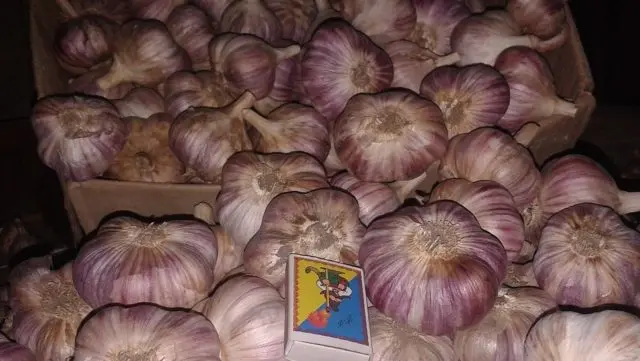
History of variety breeding
Winter garlic Lyubasha was bred by a Ukrainian gardener and vegetable grower from the Zaporozhye region I.I. Zakharenko, he was tested in 2005-2007. Spread in Our Country due to high productivity and unpretentiousness to weather conditions. The new variety has absorbed the best properties of the winter subspecies.
Description of the variety of garlic Lyubasha
Variety Lyubasha surprises with large-fruitedness due to a powerful root system. Each copy has at least 150 roots, which exceeds the performance of other known varieties. The green aerial part of the plant rises to 1-1,2 m. Under good agrotechnical conditions, it reaches 1,5 m. The width of dense standing leaves with a slight wax coating is 2-3 cm, length – 45-50 cm.
Instances growing from denticles throw arrows in the south at the end of May, in the middle lane – in June. The arrows are high, up to 1-1,1 m. The inflorescence creates from 40-60 to 120 air bulbs, each with an average weight of 15 g. There are large bulbs – 20-30 g. Sometimes arrows are also formed when they are sown. The germination rate of air bulbs with a diameter of 4-7 mm is 60-70%.
Round-flat heads of winter garlic of the Lyubasha variety are striking in size: on average, the diameter reaches 5,5-6,5 cm, weight – 65-80 g. There are 2 times larger, with a weight of 100 to 150 g. Bulbs densely covered with a white-pink husk, usually of a pale hue. The color depends on the minerals that the areas are rich in: there are Lyubasha garlic heads with intense pink-purple touches. Well-developed bulbs are divided into 375-6 large cloves. Ideally, there should be at least 7 slices. A lower number indicates the degeneration of this batch of garlic.
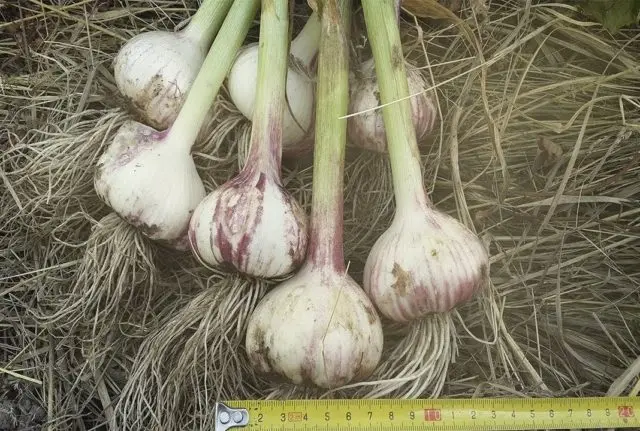
The average weight of slices of the Lyubasha variety is 6-17 g. Dense, crispy flesh of a white-cream shade. The taste is sharp, piquant, the aroma is expected, rich in specific essential oils, which are contained in 100 g up to 0,4%. A high rate of ascorbic acid – 34 mg, 43% dry matter, 0,3% allicin, 17,0 μg selenium. Bulbs of harvested garlic Lyubasha are storable, stored without loss of their taste qualities for 10 months. Use fresh slices as a seasoning for hot dishes, for marinades and canned food.
Characteristics of garlic varieties Lyubasha
A variety with excellent qualities is grown in home gardens and on plantations on an industrial scale.
Productivity of winter garlic Lyubasha
Mid-season variety ripens 3 months after spring shoots. Bulbs are dug in different regions from the end of June or in July. From 1 sq. m receive 1,5-3 kg. On the fields of agricultural enterprises with regular watering and fertilizing, Lyubasha garlic shows a yield from 1 ha to 35 centners. The fee depends on:
- from the nutritional value of the soil;
- its moisture during the drought;
- fertilizer application.
Garlic adapts well due to the developed root system to different types of soil, as well as to climatic conditions. Shows excellent productivity in dry years. In a well-mulched area, it safely tolerates frosty winters even without snow cover. An important role is played by the genetic properties of the Lyubasha variety to resist diseases. The yield and weight of the heads show the timely removal of arrows. They are torn off when they reach a length of 10 cm.

Disease and pest resistance
Garlic folk selection resistant to Fusarium. Pests also rarely attack the plant. If another variety is sick nearby, preventive procedures are carried out.
Advantages and disadvantages of the variety
According to reviews, the Lyubasha garlic variety has many advantages:
- high yield;
- early maturation;
- frost resistance;
- drought tolerance;
- adaptability to soils;
- low susceptibility to diseases.
Gardeners do not find shortcomings in the Lyubasha variety.
How to plant garlic Lyubasha
The quality of the resulting heads or the initial successful stage of its reproduction also depends on the implementation of the landing rules.
Terms of planting
When planting winter varieties of garlic, it is important to at least roughly navigate the long-term weather forecast when frosts come. The teeth must acclimatize in the soil before the onset of cold weather, this takes up to 16-20 days. This is the best time for planting winter garlic. If the slices are planted long before frost, they germinate, give above-ground shoots, which will certainly suffer in winter. Planting too late also threatens that the cloves will not take root and may die. In the southern regions, winter varieties are planted in October-November, in the middle lane – from the end of September to October 10. Soil temperature should be between 10-15 °C.
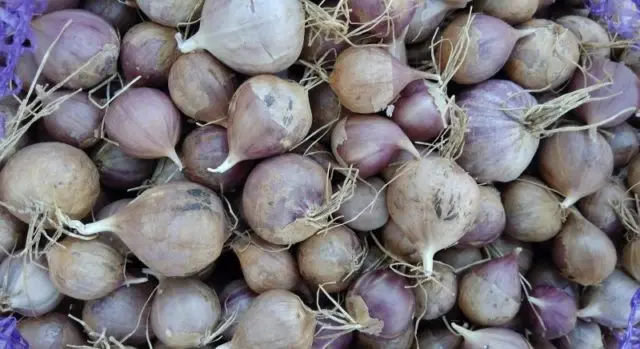
Preparation of beds
On a personal plot for Lyubasha’s garlic, a spacious place is allocated, lit by the sun, away from the shade of trees. A lowland or a small lonely hill is also not suitable. In the first case, water accumulates in such a site after the snow melts and rains, which will lead to the death of the plantings. On the hill, the snow is blown away by the wind, which further lowers the temperature, and the ground freezes deeper.
2-3 weeks before planting winter garlic Lyubasha, the plot is plowed to a depth of 30 cm, fertilized with mineral products based on potassium and phosphorus or compost, rotted humus, but not fresh manure.
Planting garlic
For those days that remain before the planting of cloves or bulbs, the grooves are watered 2-3 times. Irrigation helps compact the soil. If the garlic is planted in too loose soil, the cloves sink down, making it difficult for them to germinate. The day before planting, cloves and air bulbs are soaked for half an hour in a pink solution of potassium permanganate for disinfection. The rest of the time they are dried.
Winter garlic planting scheme:
- grooves deepen up to 7-8 cm;
- the interval between the rows of the large-fruited variety Lyubasha is 40 cm;
- the distance between the holes is 10 cm.
Wood ash is poured into the grooves. After deepening the cloves, they are sprinkled with soil and mulched with sawdust, peat, hay.
The decrease in quantity is a signal of the degeneration of this batch of garlic. Also do not plant sprouting lobules.
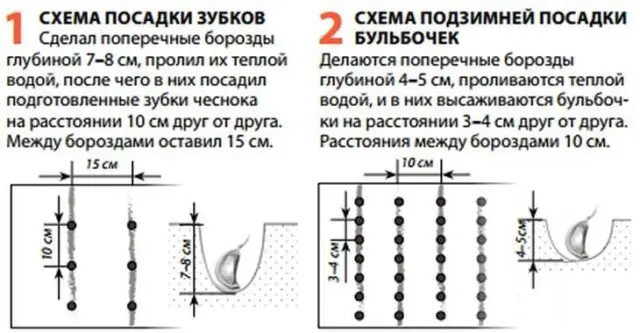
Growing garlic Lyubasha
With the onset of frost, the site is covered with leaves or spruce branches. After the snow melts, the mulch is removed. The soil is regularly loosened and weeded, on which pests and pathogens can multiply. If there are hot days without precipitation, garlic is watered 2-3 times a week. Watering is stopped 14-16 days before collecting the heads. Shooting begins at the end of May. Leave a few inflorescences for reproduction, others pinch off.
In spring, the culture is fertilized with 20 g of urea per bucket of water. They also use chicken manure, minerals. When the leaves turn yellow, the plants are supported with ammonia, hydrogen peroxide, and yeast.
Harvesting and storage of crops
Garlic is harvested in the 1st or 2nd decade of July. The heads are carefully dug up, left for 1-2 hours to dry and cleaned of soil. Under a canopy, the bulbs are dried for 1-2 weeks, then the stems are cut and laid out in boxes for storage in the basement.
How to propagate garlic
Variety Lyubasha is propagated:
- teeth into which the head is divided;
- single teeth that grew from air bulbs;
- air bulbs from a ripe inflorescence.
Any planting material of winter garlic is planted only in the fall. The difference is only in the depth of planting lobules and bulbs. The latter are sown to a depth of 5 cm. Before planting, all seeds are disinfected.
Constant, from year to year, reproduction of garlic by cloves from large heads leads to the degeneration of the species. Therefore, those gardeners who are serious about working on the ground, be sure to leave a few arrows with seeds for further reproduction.
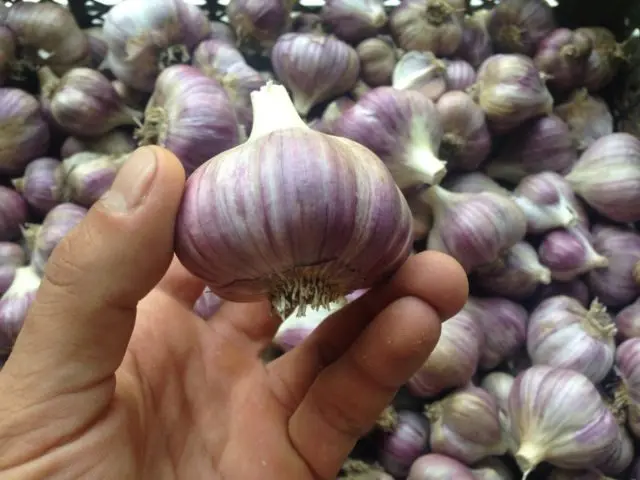
Diseases and pests, methods of control and prevention
As noted in the reviews, Lyubasha’s garlic is not affected by Fusarium, but can become infected with other fungal diseases during the growing season. For prevention, the grown rows are sprayed with the Fitosporin microbiological agent or other fungicides. Plants affected by viruses are removed.
Pests are repelled with ammonia during foliar feeding, insecticides are used. The best prevention against nematodes and mites is pre-sowing soaking of the cloves.
Conclusion
Lyubasha’s garlic is now the most productive winter variety. Planted in time, mulched for the winter, watered in the summer and protected by preventive measures against pests and diseases, garlic in July will delight you with a rich collection of large heads.









